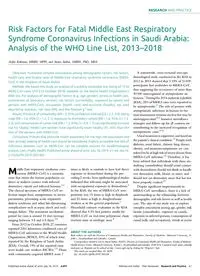
2019 Risk Factors for Fatal Middle East Respiratory Syndrome Coronavirus Infections in Saudi Arabia_ Analysis of the WHO PDF
Preview 2019 Risk Factors for Fatal Middle East Respiratory Syndrome Coronavirus Infections in Saudi Arabia_ Analysis of the WHO
Risk Factors for Fatal Middle East Respiratory Syndrome Coronavirus Infections in Saudi Arabia: Analysis of the WHO Line List, 2013–2018 Arifur Rahman, MBBS, MPH, and Atanu Sarkar, MBBS, PhD, MES Objectives. To explore complex associations among demographic factors, risk factors, health care, and fatality rates of Middle East respiratory syndrome coronavirus (MERS- CoV) in the Kingdom of Saudi Arabia. Methods. We based this study on analysis of a publicly accessible line listing of 1256 MERS-CoV cases (2013 to October 2018) available on the World Health Organization’s Web site. For analyses of demographic factors (e.g., age, gender), access to health care, promptness of laboratory services, risk factors (comorbidity, exposure to camels and persons with MERS-CoV), occupation (health care), and outcome (fatality), we used descriptive statistics, risk ratio (RR), and the Pearson c2 test. Results. Presence of comorbidity (RR = 3; 95% confidence interval [CI] = 2.2, 3.9), being male (RR = 1.6; 95% CI = 1.2, 2.1), exposure to dromedary camels (RR = 1.6; 95% CI = 1.3, 2.3), and consumption of camel milk (RR = 1.5; 95% CI = 0.9, 1.7) can significantly increase risk for fatality. Health care workers have significantly lower fatality (P < .001) than the rest of the persons with MERS-CoV. Conclusions. Policies that promote health awareness for the high-risk population and their prompt seeking of health care should be considered. Publicly accessible line lists of infectious diseases such as MERS-CoV can be valuable sources for epidemiological analysis. (Am J Public Health. Published online ahead of print July 18, 2019: e1–e6. doi:10. 2105/AJPH.2019.305186) M iddle East respiratory syndrome coro- navirus (MERS-CoV) is a zoonotic virus that enters the human population via direct or indirect contact with infected dromedary camels and infected humans.1,2 The clinical spectrum of MERS-CoV in- fection ranges from asymptomatic to severe pneumonia, presenting acute respiratory distress syndrome and other life-threatening complications such as septic shock and mul- tiorgan failure. The maximum incubation period for cases is around 14 days (average ranging between 5.5 and 6.5 days).3,4 From 2012 to October 2018, 27 countries reported 2261 laboratory-confirmed cases of MERS-CoV infections to the World Health Organization (WHO), 83% of which were reported by the Kingdom of Saudi Arabia (KSA). Overall, 19% of the reported cases were health care workers (HCWs).1,5 Those with community-acquired MERS were 7 times as likely as controls to have had direct exposure to dromedaries during the pre- ceding 2 weeks. Sero-epidemiological studies indicated that infection might be associated with occupational exposure to dromedaries.6 In the KSA, the rate of MERS-CoV sero- positivity was 15 times as high in shepherds and 23 times as high in slaughterhouse workers as in the general population.7 Household contacts evaluation in the KSA showed that 4.3% had positive results for MERS-CoV on real-time polymerase chain reaction assay or serologic assay.8 A nationwide, cross-sectional sero-epi- demiological study conducted in the KSA in 2012 to 2013 showed that 0.15% of 10 009 participants had antibodies to MERS-CoV, thus suggesting the occurrence of more than 40 000 unrecognized or asymptomatic in- fections.7 During the 2014 outbreak in Jeddah (KSA), 25% of MERS cases were reported to be asymptomatic.9 The role of persons with asymptomatic infections in human-to-hu- man transmission remains unclear but may be underappreciated.6,9 Sensitive surveillance strategies and follow-up for all contacts are contributing to the increased recognition of asymptomatic cases.9–11 Usual treatment is supportive and based on the patient’s clinical condition.12 People with diabetes, renal failure, chronic lung disease, obesity, and immunocompromise are con- sidered to be at high risk of severe disease from MERS-CoV infection.12 Therefore, it has been advised that individuals with these un- derlying comorbidities should avoid contact with dromedaries; should not drink or handle raw dromedary milk, blood, or urine; and should not eat dromedary meat that has not been properly cooked.13 Despite significant improvements in MERS-CoV surveillance, there is a lack of understanding in the relationship between demographic and risk factors as well as health care. The aim of our study was to explore complex associations among age, gender, risk factors (comorbidity, exposure to camels, exposure to infected persons, consumption of camel milk, and occupation), trends in access ABOUT THE AUTHORS Both authors are with the Division of Community Health and Humanities, Faculty of Medicine, Memorial University, St John’s, Newfoundland and Labrador, Canada. Correspondence should be sent to Atanu Sarkar, #2851, Division of Community Health and Humanities, Faculty of Medicine, Health Sciences Centre, Memorial University, St John’s, Newfoundland and Labrador, A1B 3V6, Canada (e-mail:
